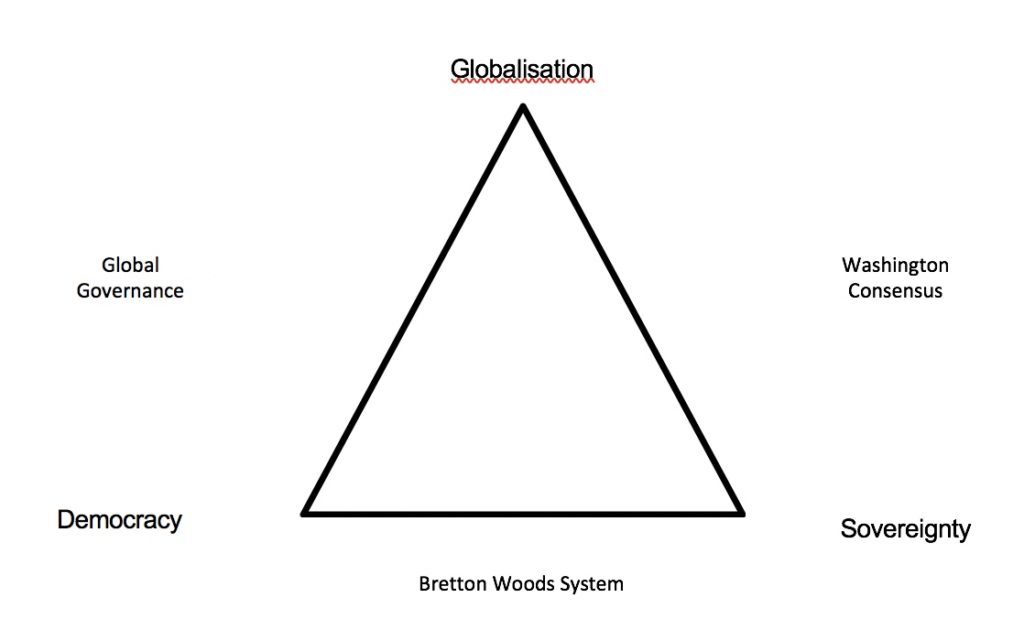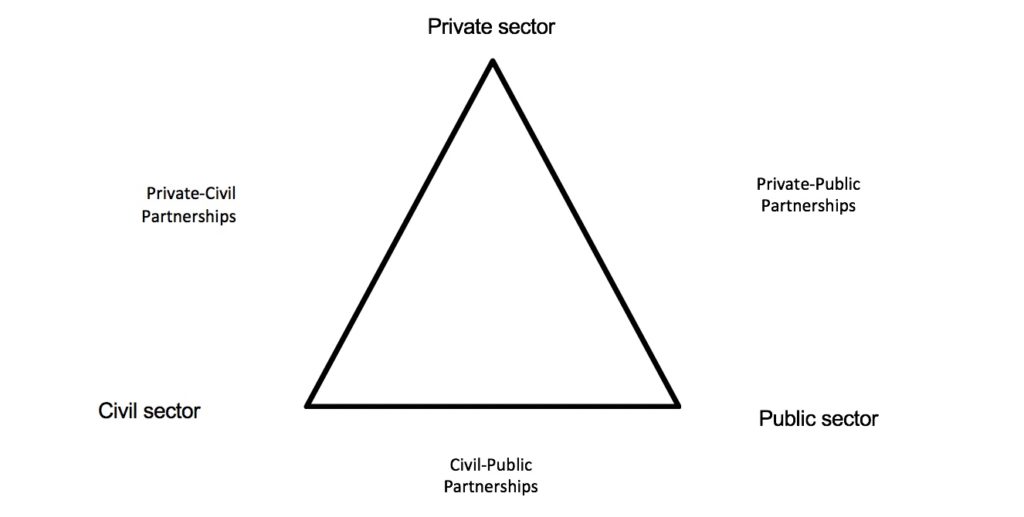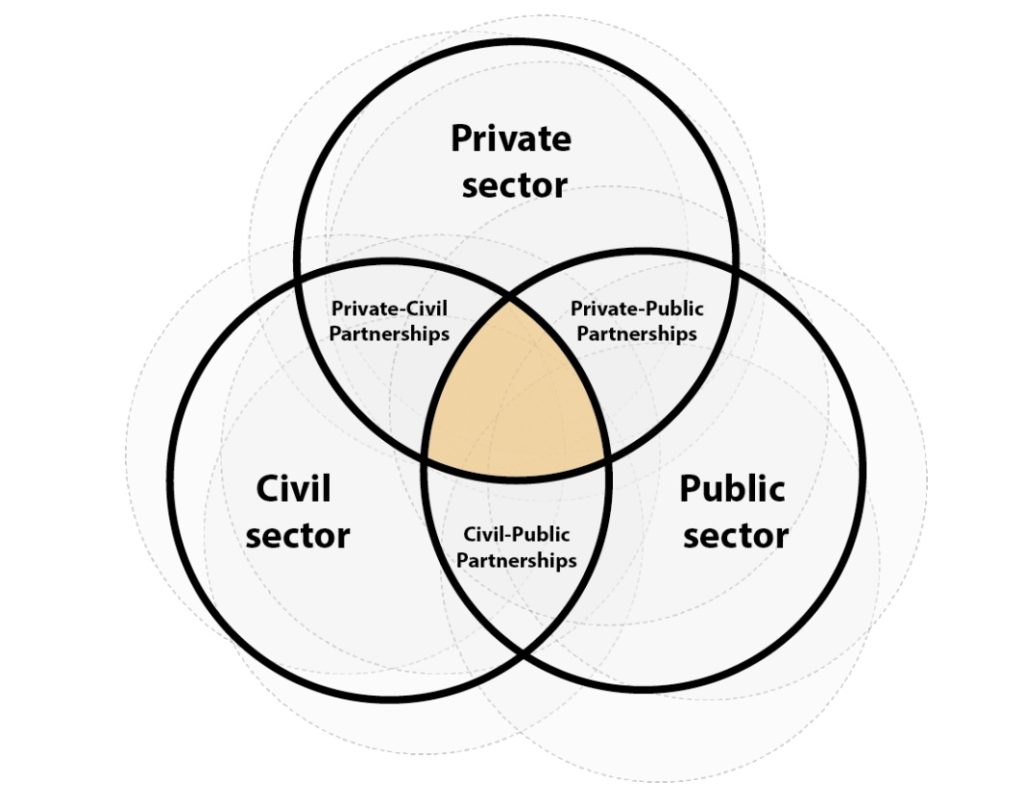
Social extrapreneurship
There is growing interest in expanding our understanding of social innovation, moving beyond social entrepreneurship to address societal challenges through different decision-making levels(1) and the collaboration of multiple actors. Social extrapreneurship(2) is a novel view of entrepreneurship: it can be defined as multi-sectoral collaboration to tackle social challenges through innovative solutions. However, as appealing as it may be to understand social entrepreneurship as a more holistic approach, in practice, social change through multiple-actor collaboration comes with its challenges.
By considering how challenging it is to generate social, political, and economic collaboration, I believe there is an apparent trilemma(3) in social extrapreneurship that prevents it from fulfilling its promise. As actors from different sectors design, launch, and run collaborative action, their chances of failure increase if they find it difficult to reconcile different businesses to result in compatibility from their differences. A lack of collaboration turns into a less diverse and plural option of social innovation. Actors often opt to strengthen the status quo and protect their own organization’s businesses/interests even when they aimed to tackle social challenges together.
Complexity and uncertainty are common features of social innovation contexts. Thus, in these contexts, organisations may stick to what they know best, if the predicted benefits from collaborating with others are unclear. Moreover, a constant pivoting in their business models emerging from this same complexity and uncertainty has the potential to make collaboration even harder. The clarity in motivation and incentives are therefore important. Failure will indicate that organisations are deciding to act individually. Social innovation is still possible. Yet, the form that is more likely to emerge is that of single actors; some sort of individual private, social, or civil social entrepreneurship(4).
The promise of social extrapreneurship
Social extrapreneurship(5) is defined as entrepreneurial action that combines resources, ideas, and people from different organisations and locations towards addressing social challenges. This process aids the recognition of the complexity of social problems and the necessity to generate innovative solutions by relying on the intervention of multiple actors from different sectors. From increasing impetus, social innovation scholarship has come to consider social extrapreneurship in the form of cross-sectoral partnerships(6) as a requirement for sustainable and systems solutions to social problems.
The drive to support collaborative actions across sectors in the practice of social innovation is equally the result of market failures and a loss of trust in public institutions. Critics point to the limitation of single organisations acting alone as they try to address social challenges. It is argued that cross-sectoral collaborations are needed due to social challenges being too vast and complex for single actor intervention. Indeed, through collaborative action there is an expected promise of collective impact(7) as it is taken to be a result of a coordination of efforts in search of a common good while solving today’s pressing social challenges.
While optimism is prevalent, I suggest that a pragmatic view is needed as innovative action and implementation of a strategy(8) are difficult to operationalise in cross-sectoral collaborations.
From a trilemma to a social innovation paradox
The difficult reconciliation for cross-sectoral collaboration towards solving social issues, led me to Dani Rodrik’s political economy trilemma(9) (Figure 1), which relates to the constant tensions between a nation’s interest for achieving globalisation e.g. international trade, global markets, democracy e.g. national policy, citizen’s participation, and sovereignty e.g. the nation-state. He argues that whilst it is possible to combine any two of those elements, it is not possible to have all three simultaneously. Roderik’s best option for globalisation is to sacrifice some measure of global economic integration in the interests of national sovereignty and democracy. In a post-capitalist era, a narrative supporting a reduction of nations’ participation in global markets certainly has gained momentum and finds present expressions in some liberal or social nationalism in different countries. Whilst it would be misleading to present Rodrik’s trilemma as support of the enlargement of the nation state, clarifying this point is not the aim here.

By taking Rodrik’s trilemma as an analogy, I wonder if a “reduction of the market” is also our best way forward for social innovation? Given that multiple sectoral collaborations are challenging, perhaps we should set our goal in promoting the participation of public and civil sectors in social innovation over private social innovative initiatives?
I accept this is our greatest way forward. However, we may prefer relatively “equal” “competitive” and “sustainable” private, public, and civil sectors. Thus, a trilemma viewpoint for social innovation is incomplete (Figure 2). A lemma-proposition (i.e. dilemma, trilemma) form of thinking
where an “either/or” solution to a problem is a dominant form, limits the possibility to understand social innovation collaboratively(10). Assessing multiple actors’ collaborations in social innovation, needs to focus our attention on understanding the best possible balance between the private, public and civil sectors.

Thus, to find balance there are two aspects that are important to consider. First, private, public, and civil sectors exist together and at the same time (Figure 3). Second, innovative action will vary according to context and will not always generate a similar response.

A starting point in finding and understanding the best balance within social innovation practice is to assume that there will always be competing demands between organisations and actors. It should be accepted that private, public and civil sectors will always co-exist. Therefore, it is important to recognise the challenges organisations encounter when different institutional logics operate together when collaboration is needed. Inevitably, this creates tensions between organisations: the private sector is founded on competition and maximisation of profit, while the public sector concerns sustaining bureaucratic structures for redistribution and planning and distinct from government and business in civil society. Indeed, there are different institutional logics by which individuals and organizations provide meaning to their activities and different frames of social innovation actions across the sectors. By recognising the presence of these tensions, a pragmatic approach should be implemented of finding the best possible balance and avoid trying to a perfect combination.
A “both/and” rational is rooted in paradoxical thinking with persistent contradiction and interdependence between elements. . For the case of multiple sectoral collaboration, embracing a paradoxical proposition suggests that while a presence of tensions in the practice of social innovation can push sectors to act individually, it is the acceptance of the presence of these tensions where the collaboration is possible in practice.
Decision-making in search of social innovation solutions becomes less about solving tensions in the form of tri/di-lemmas, trade-offs, or dichotomies and more about finding synergy (central area in convergent circles in Figure 3). It is now possible to find an infinite number of combinations when referring to private-public-civil collaborations for social innovation practice.

As a Teaching Associate for the MSt in Social Innovation, Dr Ana Aranda-Jan’s responsibilities vary greatly and include: tutoring; holding office hours; developing seminars and workshops and assisting the rest of the teaching team to provide learning support to postgraduate students.
In addition to her teaching activities, she is involved in research activity, specifically pedagogic research and her own research. Her research interests include working with topics on agenda-setting, comparative public policy, complexity in policymaking and decision-making and, innovation within government.
Ana’s research interest – https://www.researchgate.net/profile/Ana_Aranda-Jan
References
- Kramer, M. and Pfitzer, M. (2016), The Ecosystem of Shared Value. Harvard Business Review
- Tracey, P. and Stott, N. (2017), Social innovation: a window on alternative ways of organizing and innovating. Innovation, 19:1, 51-60
- Stott., N., Fava, M., Tracey, P. and Claus, L. (2020), Playing well with others? Community cross-sector work in poor places. Re-thinking Cross-Sector Social Innovation Conference, 6-7
- Stott, N. and Tracey, P. (2018), Organizing and innovating in poor places. Innovation, 20:1, 1-17
- Rodrik, D. (2011), The Globalization Paradox: Democracy and the Future of the World Economy. New York: W.W. Norton
- Ziegler, R. (2017), Social innovation as a collaborative concept. Innovation: The European Journal of Social Science Research, 30:4, 388-405
- Harvard Business Review. (2016). The Ecosystem of Shared Value.
- Crosby, B.C. and Bryson, J.M. (2010). Integrative leadership and the creation and maintenance of cross-sector collaborations. The Leadership Quarterly, 21(2), pp.211–230.
- Bolotnikova, M.N. (2019). The Trilemma. [online] Harvard Magazine.
- Ziegler, R. (2017). Social innovation as a collaborative concept. Innovation: The European Journal of Social Science Research, 30(4), pp.388–405.


julio sanchez
Muchisimas gracia, excelente artículo y un abrazo desde CHIAPAS.